Mad Hedge Biotech and Healthcare Letter
December 10, 2024
Fiat Lux
Featured Trade:
(THE INSURANCE COMPANY ALWAYS RINGS TWICE)
(UNH), (CI), (CVS), (HUM), (AMGN), (BIIB), (GILD)

Mad Hedge Biotech and Healthcare Letter
December 10, 2024
Fiat Lux
Featured Trade:
(THE INSURANCE COMPANY ALWAYS RINGS TWICE)
(UNH), (CI), (CVS), (HUM), (AMGN), (BIIB), (GILD)

Got an interesting call yesterday from an old college buddy - let's call him Bob. We go way back to our UCLA days, before I headed to Tokyo and he went into tech.
He was fuming because UnitedHealth (UNH) just denied his family's third claim this year, something about an "experimental treatment" for his daughter's rare condition.
Coming from a guy who just cashed out of his third startup, hearing him rant about insurance bureaucracy was pretty rich.
Still, his situation got me thinking. After hanging up, I dug into what's really happening with insurance stocks, and the picture isn't pretty.
UnitedHealth Group, our nation's biggest health insurer, just had its worst week in years - dropping 9.5% after one of their executives was tragically murdered, which sparked an unexpected spotlight on their claims practices.
Cigna (CI) and CVS Health (CVS) caught the same downdraft, falling 4.5% and 5% respectively.
But here's what really caught my attention: UnitedHealthcare's denial rate for Medicare Advantage claims has more than doubled since 2020, hitting 22.7% last year.
Interestingly, this spike happened right as they rolled out new automation processes. Funny how that works, isn't it?
Experian Health's latest report shows this isn't isolated - 73% of healthcare providers are reporting more denials than ever, with processing times stretching longer and longer.
The cost of this trend? The Council for Affordable Quality Healthcare estimates $31 billion annually in administrative expenses alone.
Meanwhile, biotech companies find themselves in an awkward position. They're developing treatments that cost more than a house in the Hamptons and then need these very same insurers to make them accessible.
Amgen's (AMGN) been crushing it with their human therapeutics portfolio, pulling in $28.2 billion in revenue last year.
Biogen's (BIIB) making serious moves in neurological treatments, though their path has been rockier - just ask anyone who followed the Aduhelm saga.
Gilead Sciences (GILD), our antiviral champions, have managed to stay above the fray, partly because their HIV and hepatitis treatments have become standard of care.
But even these giants must wonder:: as insurers tighten their prior authorization screws, what happens to patient access?
These biotechs spend billions developing breakthrough treatments - Amgen alone dropped $4.4 billion on R&D last year - only to face the insurance industry's equivalent of "computer says no."
The irony isn't lost on anyone: insurers need innovative treatments to justify their premiums, while biotech needs insurance coverage to justify their R&D spending.
It's a delicate dance that's worked reasonably well so far, but these rising denial rates have everyone on edge. Just last quarter, we saw several biotech earnings calls dominated by questions about insurance coverage rather than clinical trials.
So what should we do? Well, I say UnitedHealth and Cigna are "holds" right now - the current turbulence needs time to settle.
CVS Health is showing broader operational challenges that suggest it might be wise to consider selling. But Humana (HUM), with their strong Medicare Advantage presence, looks promising.
On the biotech side, Gilead looks like an excellent stock to buy on the dip. Its leadership in antivirals and solid pipeline make it compelling.
Amgen and Biogen? Keep them on your watch list while they try to find their footing in this situation.
Bob texted me again this morning - turns out he's filing an appeal with help from one of Silicon Valley's top healthcare attorneys. Typical Bob, bringing a cannon to a knife fight.
But maybe that's exactly what this sector needs right now - some heavy artillery to shake up the status quo.
For those willing to dodge the crossfire, there might just be some spoils of war worth picking up. After all, fortune favors the bold—and sometimes, the heavily armed.
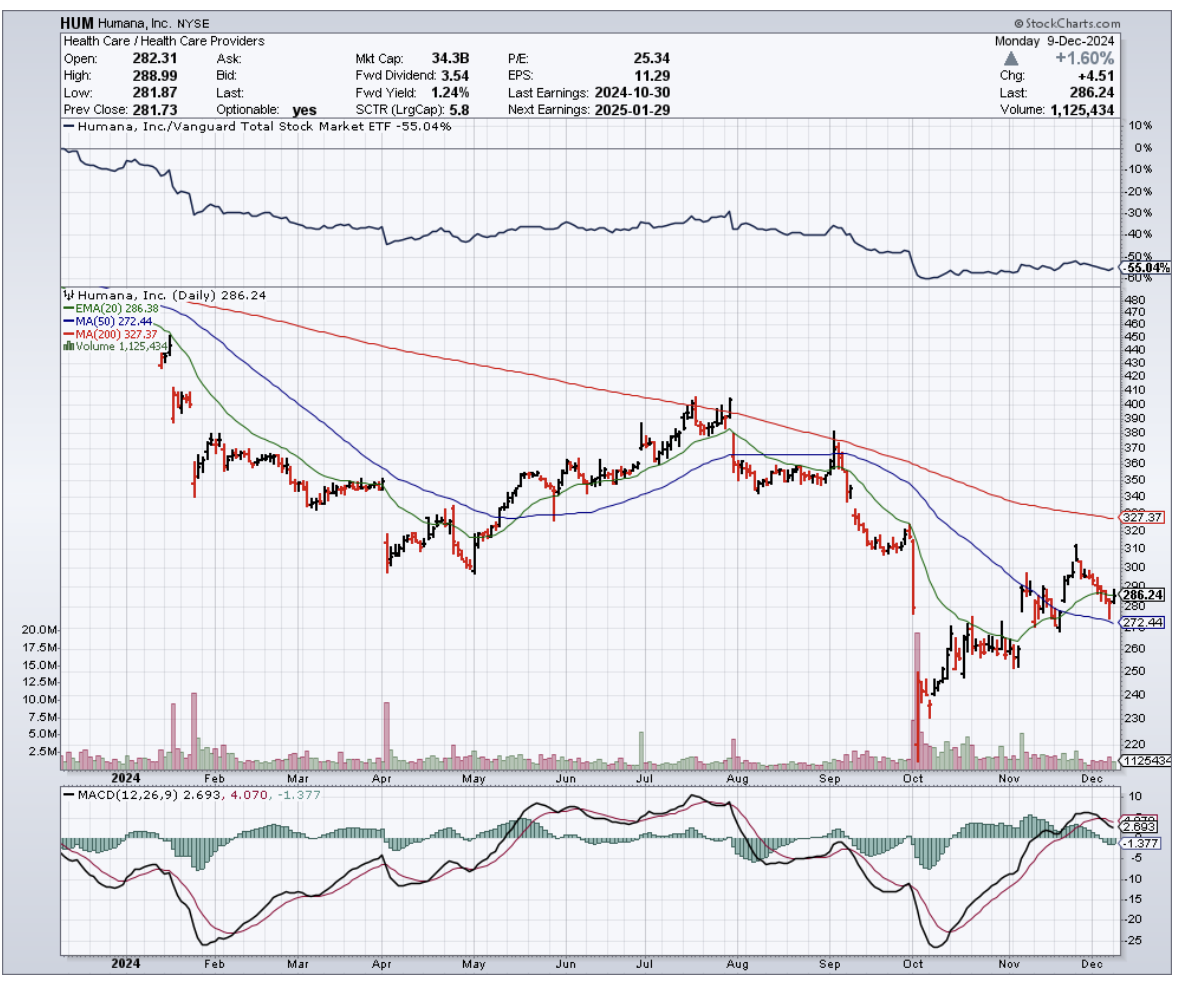
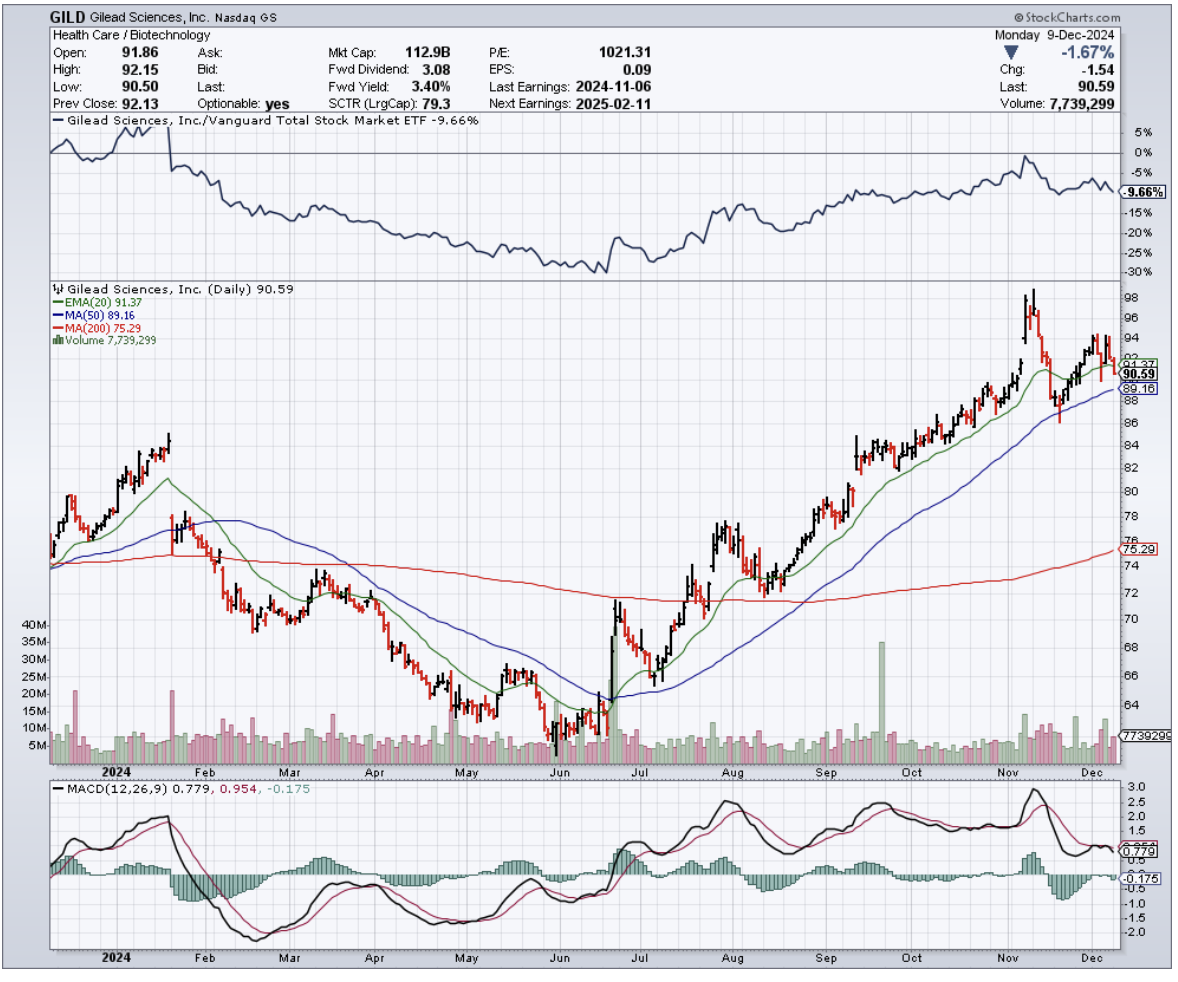
Mad Hedge Biotech and Healthcare Letter
December 5, 2024
Fiat Lux
Featured Trade:
(GRANT EXPECTATIONS)
(TXG), (ILMN), (TMO), (DHR)

The first time I visited the National Institutes of Health (NIH), I got lost trying to find the bathroom and ended up in a lab where someone was studying glow-in-the-dark zebrafish.
"Wrong door," the researcher said, "but at least you didn't walk in on the fruit fly mating experiments."
Such wrong turns seem oddly fitting now as the NIH, with its $45 billion research budget, navigates its own unexpected direction under new director Dr. Jay Bhattacharya.
This reminds me of a conversation I had with a university tech transfer officer who once described the grant distribution process as "academic musical chairs but with billion-dollar stakes."
Bhattacharya seems determined to change the tune, proposing limits on how many grants individual researchers can hoard like squirrels before winter.
It's a move that has some biotech companies sweating through their lab coats, particularly 10x Genomics (TXG), whose financial statements show a quarter of their revenue sprouting from NIH grants like bacteria in a petri dish.
The last time someone tried to cap grants—back in 2017—the scientific community reacted as if someone had suggested replacing peer review with a Magic 8-Ball.
The proposal was quietly buried in the bureaucratic equivalent of a drawer labeled "Ideas We'd Rather Forget." But like that mysterious experiment growing in the back of the lab fridge, it's back.
Meanwhile, Robert F. Kennedy Jr. has been making noise about trimming the NIH's organizational chart. While Kennedy's influence carries weight, Congress still holds the purse strings, and they've historically treated the NIH like their favorite child at allowance time.
Bhattacharya's critique of the NIH's traditionally cautious approach to funding feels like watching someone suggest skydiving to their risk-averse aunt.
He's pushing for more high-risk, high-reward projects, which could be a windfall for companies playing in cutting-edge sandboxes like CRISPR and AI-driven diagnostics.
Illumina (ILMN) and 10x Genomics are practically salivating at the possibilities, while established institutions might find themselves feeling like that last teenager picked for the dodgeball team.
The global picture adds another layer of intrigue to these changes. While we're debating grant caps and organizational reshuffling, China has been quietly doubling its biotech investments over the past decade, particularly in regenerative medicine and precision oncology.
If NIH reforms stumble, U.S. companies could find themselves playing catch-up. For those who want to take part in the action, this presents an opportunity to diversify.
International markets with increasing government funding for biotech offer new avenues for growth. Global biotech ETFs could also serve as a hedge against domestic uncertainties.
Against this backdrop, diversification becomes key. Consider companies with revenue streams less tethered to NIH funding.
Thermo Fisher Scientific (TMO) and Danaher (DHR), for example, boast a global footprint that cushions them against domestic policy shifts.
After all, the global life sciences tools market, valued at $52 billion today, is projected to grow to $95 billion by 2030, with a Compound Annual Growth Rate (CAGR) of nearly 15.89%.
Emerging frontiers like gene therapy and personalized medicine also deserve attention. These fields aren’t just buzzwords—they’re the future of biotech.
ETFs focused on genomic innovation, like the ARK Genomic Revolution ETF (ARKG), provide exposure to high-growth sectors while spreading risk.
So, what’s the play here? Well, investment opportunities in this space will depend on your appetite for disruption.
10x Genomics presents an intriguing case at $15.90. Yes, up to 25% of its revenue comes from NIH funding, making it vulnerable to policy shifts.
But this same connection positions them perfectly to benefit from Bhattacharya's high-reward research initiative. The upside potential here is massive for those willing to weather some volatility.
Illumina stands out at $144.15 as a different kind of opportunity.
Their lock on the genomic sequencing market combined with aggressive R&D investments offers that rare combination: steady performance with genuine growth potential. Think of it as smart defense for your biotech portfolio.
Then there's Thermo Fisher Scientific, trading at $529.63. Their global reach and diverse revenue streams make them remarkably resilient to NIH policy changes.
The stock won't double overnight, but it offers the kind of reliability that lets you sleep soundly.
In the end, the NIH's transformation under Bhattacharya feels a bit like watching a scientist redesign an experiment mid-trial. Some see doom and gloom in these changes, while others spot golden opportunities.
But if you ask me whether the biotech glass is half empty or half full, I'd say we're missing the point entirely—in this industry, the glass has always been refillable.
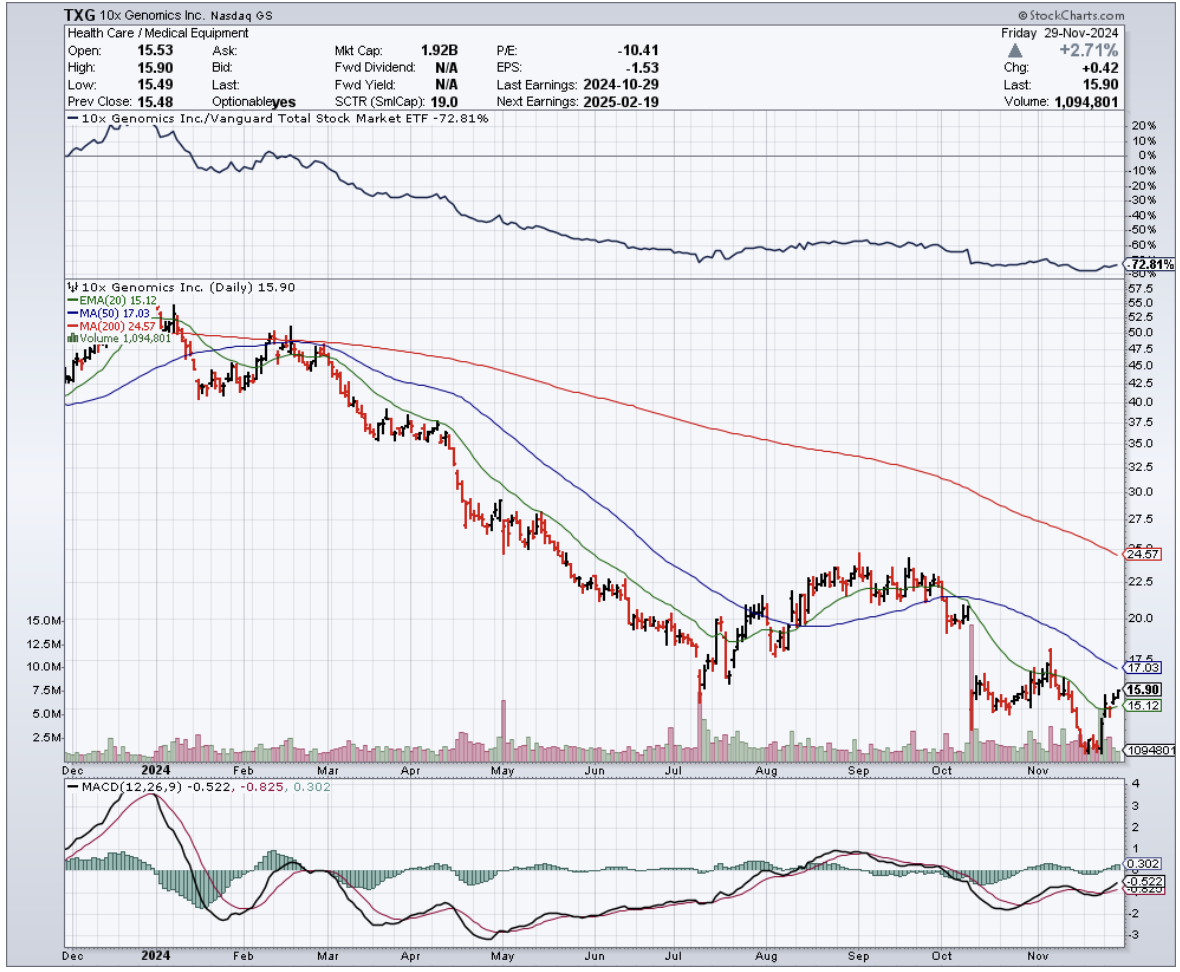
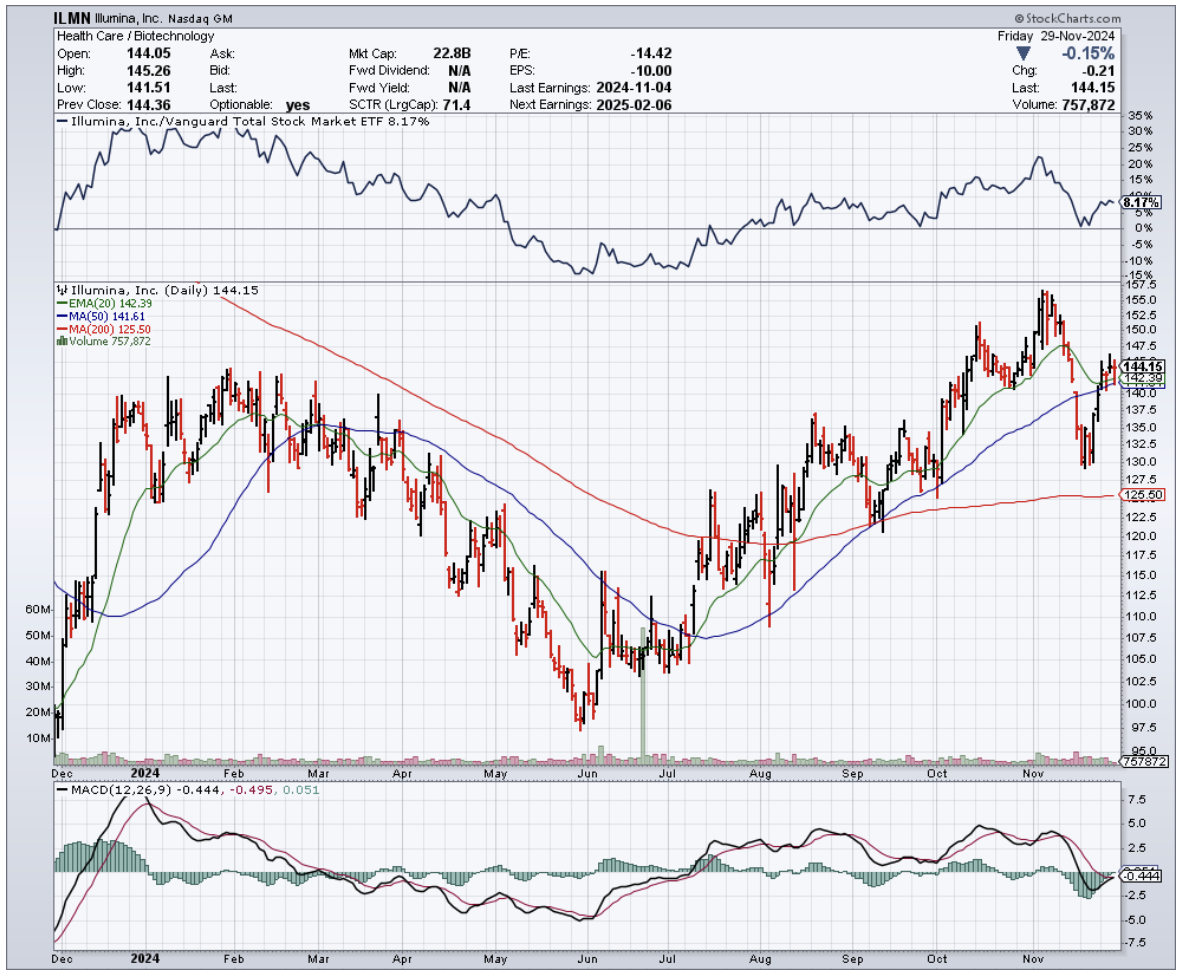
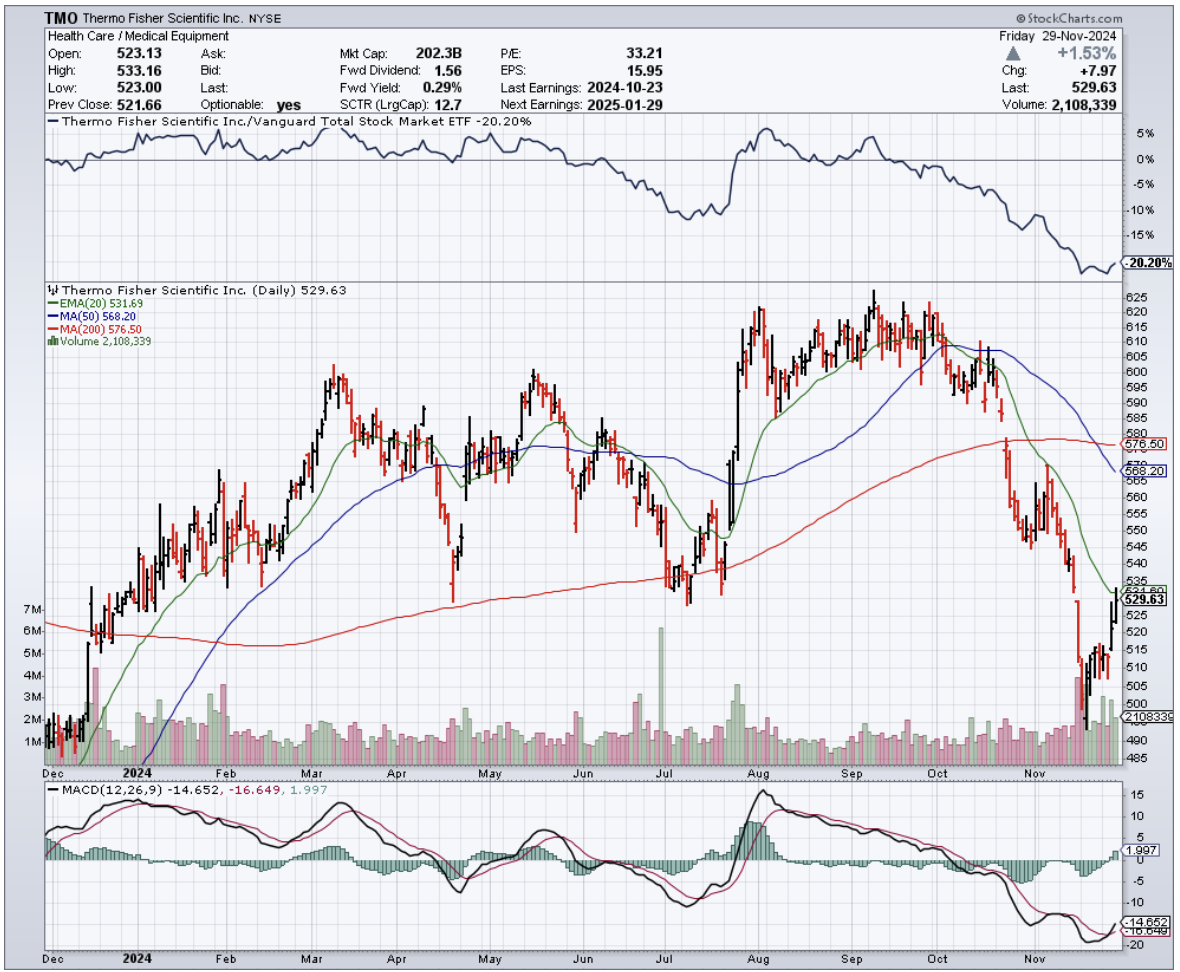
Mad Hedge Biotech and Healthcare Letter
December 3, 2024
Fiat Lux
Featured Trade:
(EYE SPY THE NEXT BIG THING)
(LCTX), (RHHBY), (ALPMY), (ADVM), (EDIT), (RGNX)

Who knew that the path to restored vision would involve recycling?
Not the kind where you sort plastics from paper, but the fascinating world of cellular hand-me-downs, where scientists are taking stem cells - nature's ultimate blank slate - and transforming them into made-to-order eye parts.
While most medical breakthroughs involve pills, patches, or the occasional well-placed zap of electricity, doctors have managed something far more incredible: they've successfully restored vision in multiple patients by essentially giving their eyes a cellular renovation via stem cell transplants.
But before you picture entire eyeballs being swapped out like lightbulbs, let me explain: We're talking about precision repair work at the cellular level, particularly targeting the notorious troublemakers of the vision world - macular degeneration and corneal damage.
The numbers behind this story are enough to make your eyes pop (sorry, couldn't resist).
Nearly 20 million Americans over 40 are currently living with age-related macular degeneration (AMD). That's more people than the entire population of New York City, all dealing with various stages of vision loss.
Break it down further, and you've got 18.34 million people with early-stage AMD and 1.49 million with the late-stage version, according to those number-crunchers at JAMA Network.
And once you hit 75, your chances of having AMD jump to nearly 30% - not exactly the golden years surprise package anyone's hoping for.
Here's where things get interesting - and by interesting, I mean expensive.
The National Eye Institute estimates that vision loss costs the U.S. about $139 billion annually. That's not just medical bills. It's everything from lost productivity to the cost of assistance devices and support services.
To put this in context, $139 billion could buy every resident of California a lifetime supply of carrots - though that wouldn't help their eyesight nearly as much as stem cell therapy.
Speaking of which, the stem cell therapy market, currently valued at a modest $456 million (pocket change in pharmaceutical terms), is expected to bulk up considerably, growing at a clip of 25.23% annually from 2025 to 2030.
By 2032, we're looking at a market worth $56.15 billion. That's what financial types call a growth opportunity, and what I call a lot of zeros.
Now, let’s take a look at the companies betting big on this cellular vision quest.
Lineage Cell Therapeutics (LCTX) is developing something called OpRegen, which sounds ominous but is actually a therapy using retinal pigment epithelium cells.
They must be onto something because Roche’s (RHHBY) Genentech liked it enough to throw $670 million at them in a collaboration deal.
Then there's Astellas Pharma (ALPMY), working on their own vision-restoration treatment, and Adverum Biotechnologies (ADVM), which is taking a slightly different approach with gene therapy.
Editas Medicine (EDIT) is getting even fancier, using CRISPR technology - think molecular scissors for DNA - to snip out the bad bits causing blindness.
Regenxbio (RGNX) rounds out our vision-quest dream team with their work on something called RGX-314, which uses viral vectors to deliver therapy (think of it as FedEx for genes).
The whole field of regenerative medicine, currently a $13.3 billion industry, is expected to grow exponentially, with projections showing a 23.3% annual growth rate by 2030.
That's significant considering the vision restoration market alone is worth $30 billion globally, with plenty of room to expand. Of course, that’s assuming these treatments make it through the regulatory obstacle course.
For one, there's the FDA to convince, manufacturing challenges to solve (turns out, growing eye cells at scale is tricky), and the ever-present question of who's going to pay for it all.
But given the alternative - a future where millions more lose their vision to degenerative diseases - the motivation to solve these challenges is crystal clear.
For those watching this space, I advise adding these names to your watchlist. After all, the future of vision care isn't just about getting better glasses or contact lenses anymore - it's now about regrowing the parts of the eye that wear out.
And that's a vision worth keeping an eye on (last eye pun, I promise).
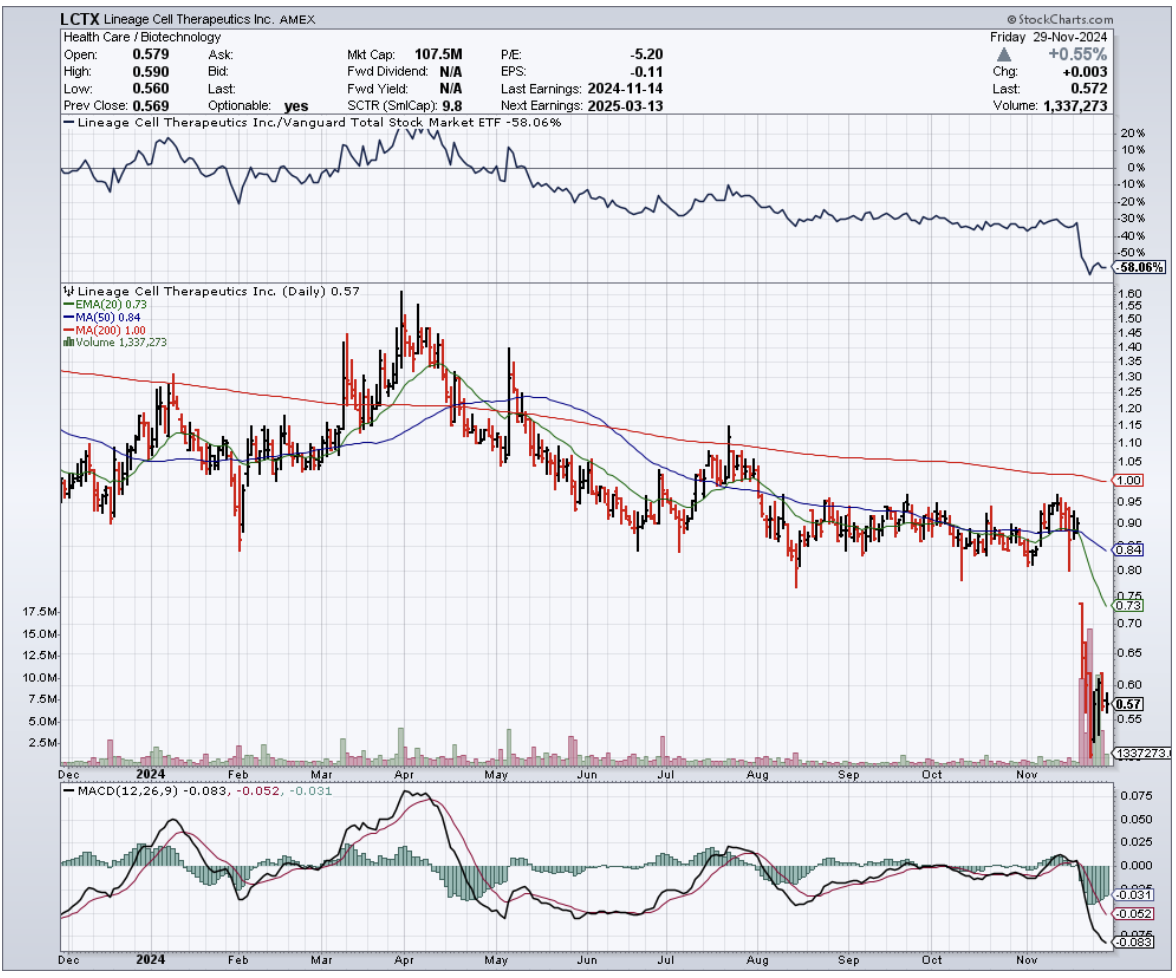
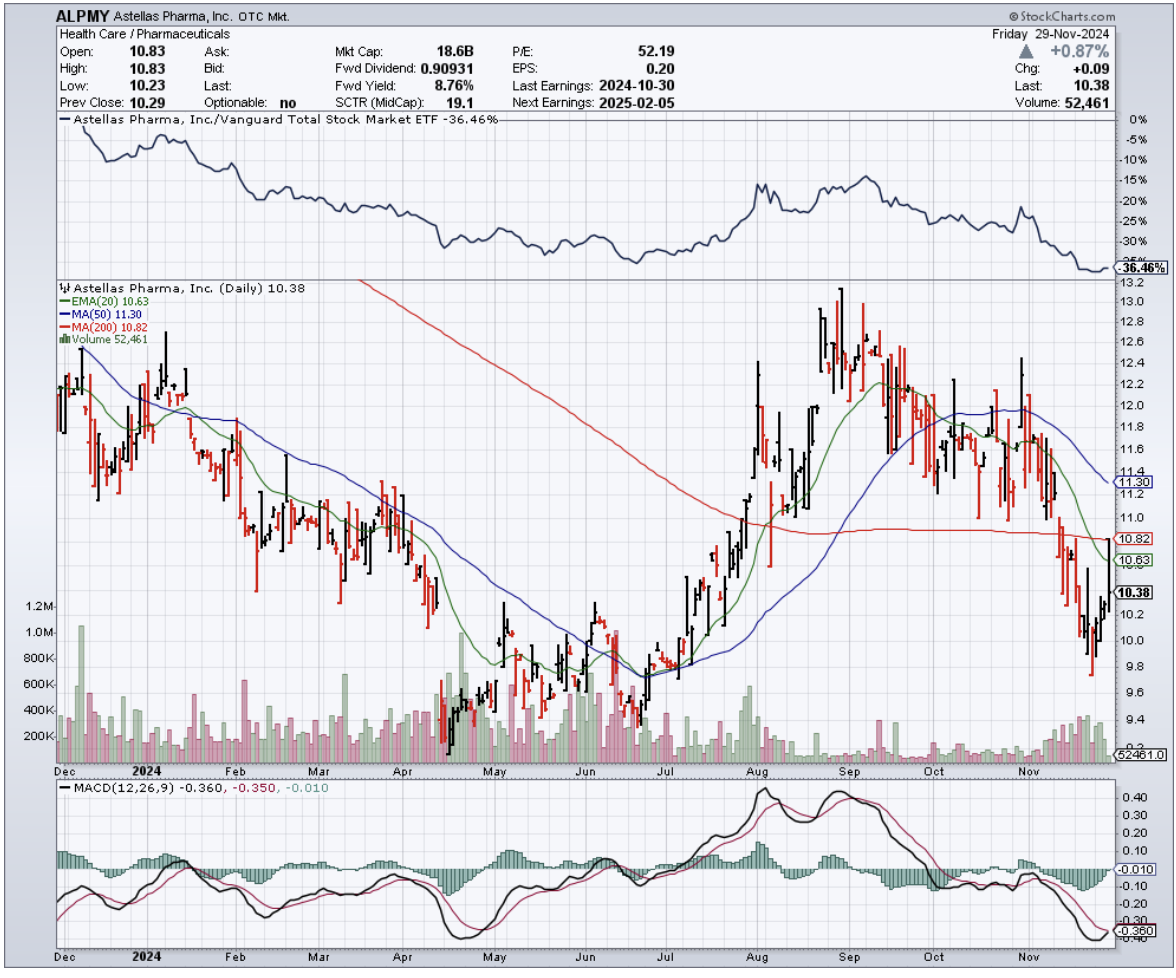
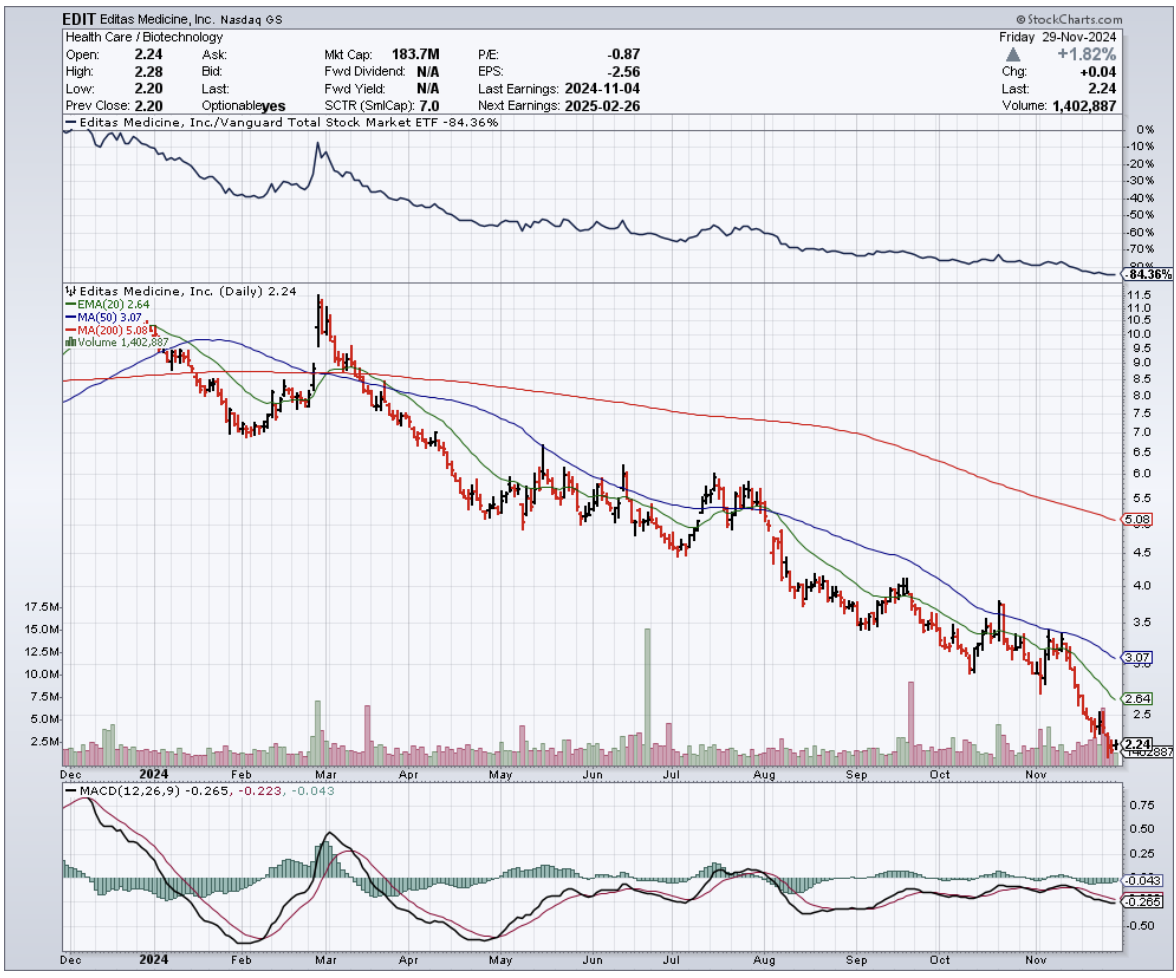
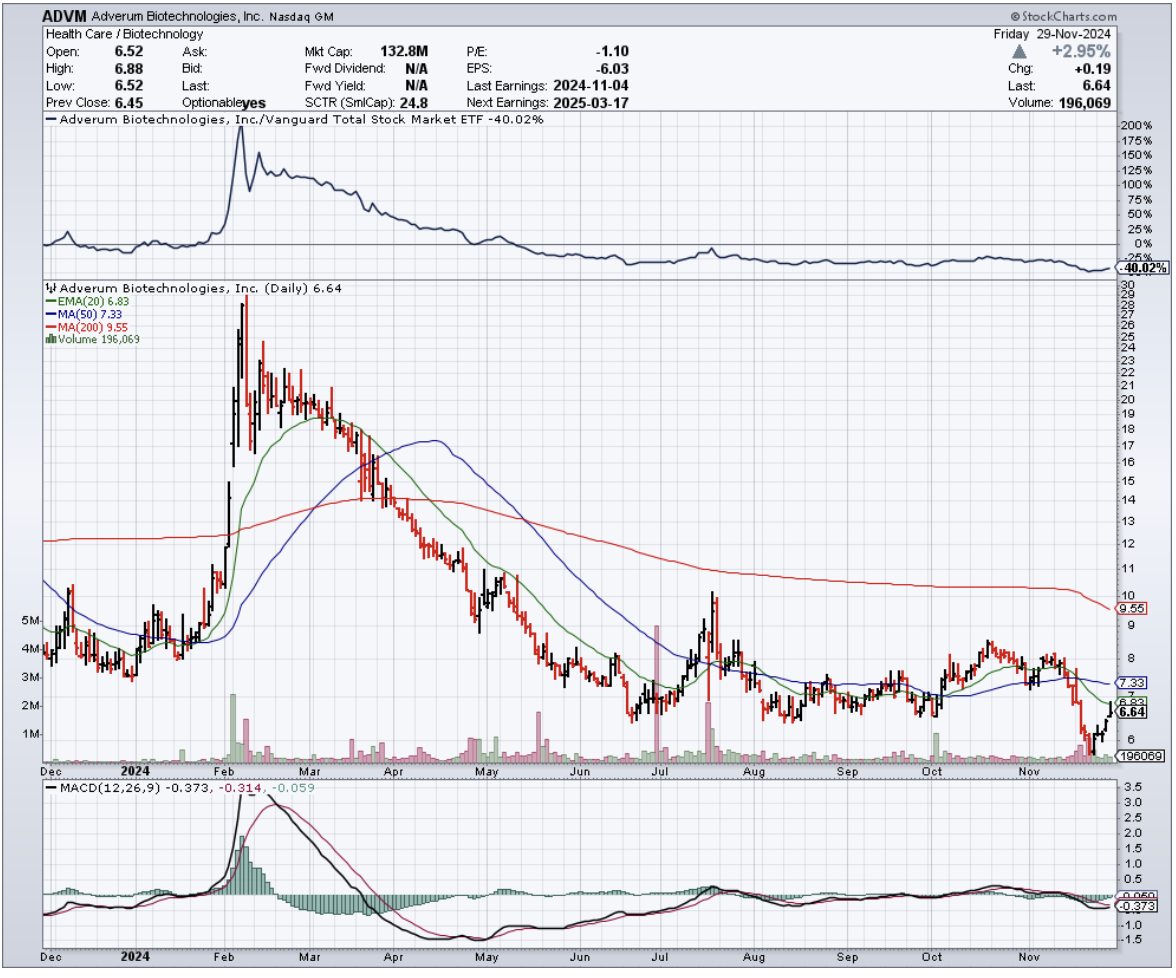
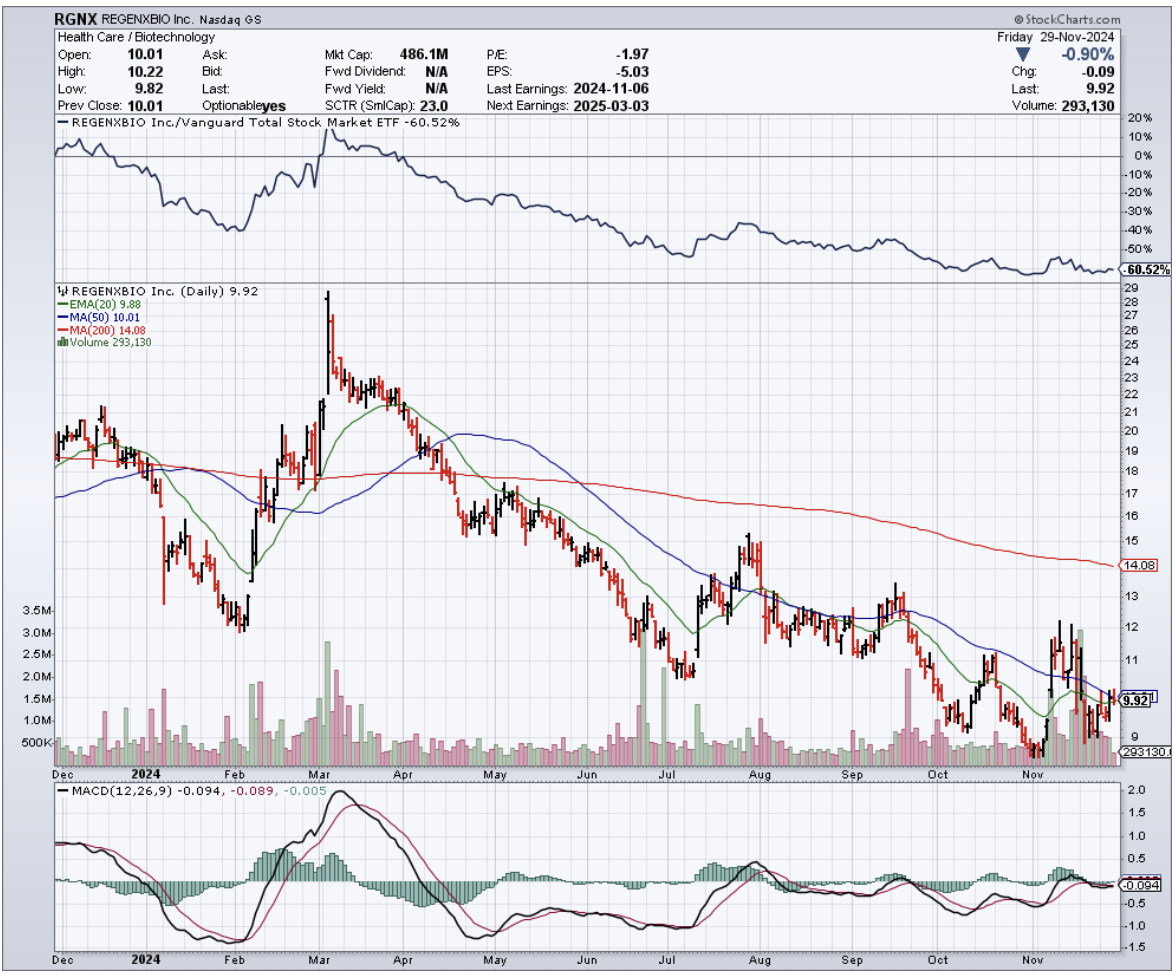
Mad Hedge Biotech and Healthcare Letter
November 26, 2024
Fiat Lux
Featured Trade:
(NO MORE EATING AT YOU)
(PFE), (LLY), (NVO), (AMGN), (RYTM), (ALT)

In 1903, the original “diet miracle” was invented—tapeworm pills. Yes, people willingly ingested parasites to lose weight.
Thankfully, modern weight-loss drugs have evolved to become a bit more... palatable. Enter Pfizer (PFE), taking the pharmaceutical stage in Q3 2024 with a performance that’s anything but parasitic.
Pfizer just reported a stunning $17.7 billion in Q3 2024 revenue—a 31% year-over-year increase that has nothing to do with parasites and everything to do with strategic positioning.
But here's where it gets interesting. Even if you strip away Pfizer's COVID-19 products (which, let's face it, had their moment like platform shoes in the '70s), they're still sitting pretty with $13.6 billion in revenue.
That's a 14% operational increase that has nothing to do with our old friend coronavirus.
Meanwhile, in the weight-loss corner of the ring, Eli Lilly (LLY) and Novo Nordisk (NVO) are experiencing what we might delicately call "growing pains."
Eli Lilly reported $11.44 billion in Q3 revenue—impressive until you consider analysts expected $12.18 billion.
Novo Nordisk's story is even more peculiar. Their weight-loss wonder drug Wegovy is selling like hotcakes (irony noted) at 17.3 billion Danish krone (about $2.75 billion USD).
But here's the catch: Novo Nordisk can't make enough of it. It's the pharmaceutical equivalent of having a hit restaurant where half the menu items are perpetually "sold out."
This shortage highlights just how insatiable the market's appetite for these drugs has become.
In 2023 alone, the US market for prescription weight-loss drugs more than doubled from $5.1 billion to $11.9 billion.
Gone are the days of dubious diet pills and miracle cures. We're witnessing the dawn of scientifically backed weight management solutions.
As for Pfizer, they’re not content to watch from the sidelines. They're developing something called danuglipron (a name that sounds like it was conceived during a particularly intense game of Scrabble). It's an oral weight-loss drug currently in Phase 2B trials.
Danuglipron’s key selling point? It's an oral medication—no needles required.
As someone who once spent three months investigating the science of injection phobia for a story, I can confirm this detail matters more than you might think.
Pfizer’s plans go beyond just one drug. In the first 9 months of 2024, they invested $7.8 billion in R&D.
Their recent acquisition of Seagen has already contributed $854 million in Q3 2024 revenue, proving that their strategy of buying innovation is paying off.
In fact, they're so confident about their trajectory that they've raised their full-year 2024 revenue guidance to between $61 billion and $64 billion.
But let's talk about the elephant in the pharmacy – regulatory approval. The FDA, bless their bureaucratic hearts, has been keeping everyone on their toes with their evolving stance on weight-loss drugs and other treatments.
Still, Pfizer managed to snag approvals for two new drugs in October 2024: Abrysvo (for RSV in adults) and Hympavzi (for hemophilia).
Both approvals came through in October 2024, showing off Pfizer’s ability to navigate modern pharmaceutical regulations.
Looking globally, the weight loss and obesity management market is projected to grow from $14.51 billion in 2024 to $48.39 billion by 2034.
Of course, no good pharma story is complete without a plot twist. Pfizer's oncology drug Ibrance saw a 12% operational decrease in Q3 2024 revenue, reminding us that even pharmaceutical juggernauts can stub their toes.
And those patents? They're like time bombs ticking away in the legal department's filing cabinet.
The obesity field is attracting new players, too. Amgen (AMGN) is developing MariTide, while Rhythm Pharmaceuticals (RYTM) focuses on genetic obesity disorders.
Altimmune's (ALT) pemvidutide is showing promising Phase 2 results, adding to the increasingly crowded field of weight-loss treatments.
So, where should you park your money? Here’s a quick guide to the stocks worth scooping up when the market takes a breather.
Novo Nordisk remains the heavyweight champion of weight-loss drugs, with Wegovy and Ozempic bringing in the big bucks. Yes, they're wrestling with production issues, but their first-mover advantage and global reach make them a solid buy for the long haul.
Eli Lilly, with Mounjaro and the freshly minted Zepbound, deserves a spot in your portfolio too. Their supply chain headaches are likely temporary, and their pipeline is bursting with potential.
Pfizer, our surprising comeback kid, rounds out the list. They might be fashionably late to the weight-loss party, but their diversification strategy and that promising GLP-1 pill in development make them worth your investment dollars. Plus, their global reach could give them an edge against their competitors.
On the hold list, we’ve got Amgen and Rhythm Pharmaceuticals—stocks you might want to keep an eye on but not necessarily dive into headfirst just yet.
Amgen's MariTide shows promise, but they're playing in a very crowded pool. Rhythm's focus on genetic obesity disorders is fascinating, but they're like a promising indie band - they might hit it big, or they might not.
As for Altimmune and Viking Therapeutics? Sometimes you need to know when to fold 'em. Despite promising early results, they're up against giants with deeper pockets and better-established supply chains.
Unless you enjoy roller coasters without safety bars, consider redirecting those investment dollars elsewhere.
Looking back, we've come an astonishingly long way from those desperate days of tapeworm pills—turns out the real money wasn't in selling parasites, but in pioneering their prescription-strength replacements.
And that's the kind of progress that would make those 1903 tapeworm salesmen drop their jaws (and hopefully nothing else).

Mad Hedge Biotech and Healthcare Letter
November 21, 2024
Fiat Lux
Featured Trade:
(TRACE ELEMENTS)
(SNY), (MTZPY), (BIIB), (IONS), (AMLX)

In a corner office somewhere in Cambridge, Massachusetts, a team of scientists is attempting something that sounds like it belongs in a sci-fi novel: they're trying to reprogram the genetic instructions that tell our neurons how to behave.
If they succeed, they might help 97% of people with ALS keep their neurons from self-destructing.
Welcome to Trace Neuroscience, where $101 million in venture capital is betting on what amounts to a molecular spell-check for your nervous system.
You might be wondering, as I did, how one starts a company with the audacious goal of tackling one of medicine's most notorious puzzle boxes.
The answer, it turns out, involves three scientists, working in three different labs, who all stumbled upon the same cellular culprit – a protein called UNC13A - the sort of name that makes you wonder if scientists moonlight as license plate generators.
But to understand why UNC13A has everyone buzzing, we need to talk about ALS itself.
ALS, if you're not familiar with it, is the kind of disease that keeps neurologists up at night. Every year, it claims about 5,000 new victims in the US alone, and we still don't know what causes 90% of cases.
Here's a simple way to envision it – think of your nervous system as a complex metropolitan subway system.
ALS is like having someone systematically shut down every station, one by one, until the entire network grinds to a halt. Despite decades of research and millions in funding, we're still mostly watching helplessly as stations go dark.
Sure, the global market for ALS treatments reached $667.3 million in 2023, but that impressive-sounding number masks an uncomfortable truth: we're still barely keeping the lights on, let alone fixing the underlying problem.
The current FDA-approved medications, Sanofi’s (SNY) Riluzole and Mitsubishi Tanabe Pharma’s (MTZPY) Edaravone (marketed as Radicava), are like trying to stop a flood with a handful of sandbags. They might slow things down a bit, but they're not exactly what you'd call a solution.
So how do you tackle a troublemaker like UNC13A? Enter Trace Neuroscience's bold approach: antisense oligonucleotides, or ASOs for those who don't enjoy tongue twisters.
Think of ASOs as tiny molecular scissors that can edit the body's protein-making instructions with surprising precision - in this case, they're specifically designed to fix how UNC13A behaves when it goes rogue.
The science behind this approach comes from a rather serendipitous confluence of research.
Aaron Gitler at Stanford, Pietro Fratta at University College London, and Michael Ward at the NIH – three scientists who probably should have just gotten a group chat going – independently discovered how certain RNA-processing molecules go haywire in ALS patients.
It's like they each found a different piece of the same puzzle, and when they put them together, the picture suddenly made sense.
And where there's breakthrough science in biotech, money usually follows.
In November 2024, Trace managed to convince some of the biggest names in venture capital – Third Rock Ventures, Atlas Venture, GV (formerly Google Ventures), and RA Capital Management – to part with $101 million.
That's quite a vote of confidence for a company whose main product is still theoretical.
The timing couldn't be more interesting. The ALS treatment market is expected to grow at a rather specific 5.8% per year until 2030, reaching about $1.1 billion.
But in this field, even the success stories come with asterisks.
Take Biogen's (BIIB) Qalsody, which got FDA-approved in May 2024 despite not actually meeting its main trial goals.
It's a rare win in a field where the scoreboard has been mostly zeros, as the rest of the ALS treatment landscape makes painfully clear.
Ionis Pharmaceuticals (IONS) had to shut down their ALS program with Biogen in May 2024, and Amylyx Pharmaceuticals (AMLX) faced the bitter task of pulling their drug Relyvrio from the market in April 2024, laying off 70% of their staff in the process.
These setbacks illuminate an uncomfortable truth about ALS drug development: the path from lab bench to pharmacy shelf is paved with perfectly logical theories that simply didn't work in real bodies.
The math is brutal - only 6.2% of neurological drugs survive the journey from Phase I to approval. Trace's response to these odds? Assemble a team that's seen enough clinical trial failures to know how to (hopefully) avoid them.
Their CEO, Eric Green, M.D., Ph.D., leads a squad that includes Chief Medical Officer Irina Antonijevic and Chief Operating Officer Megan Baierlein.
They're aiming to start clinical trials by early 2026, which in drug development terms is practically tomorrow.
For investors, timing like this transforms Trace from a scientific curiosity into a near-term catalyst.
Their approach - anchored in genetic evidence and measurable biomarkers - stands out in a field where most companies are still shooting in the dark with better bullets.
The story of Trace Neuroscience reads like molecular medicine's version of going from medieval star-gazing to GPS navigation.
While traditional ALS treatments chase symptoms, Trace is tracking proteins with the precision of an atomic clock.
They've transformed one of medicine's most frustrating puzzles into something remarkably concrete: either their molecular markers will move, or they won't.
In the biotech world, that kind of clarity is worth watching.
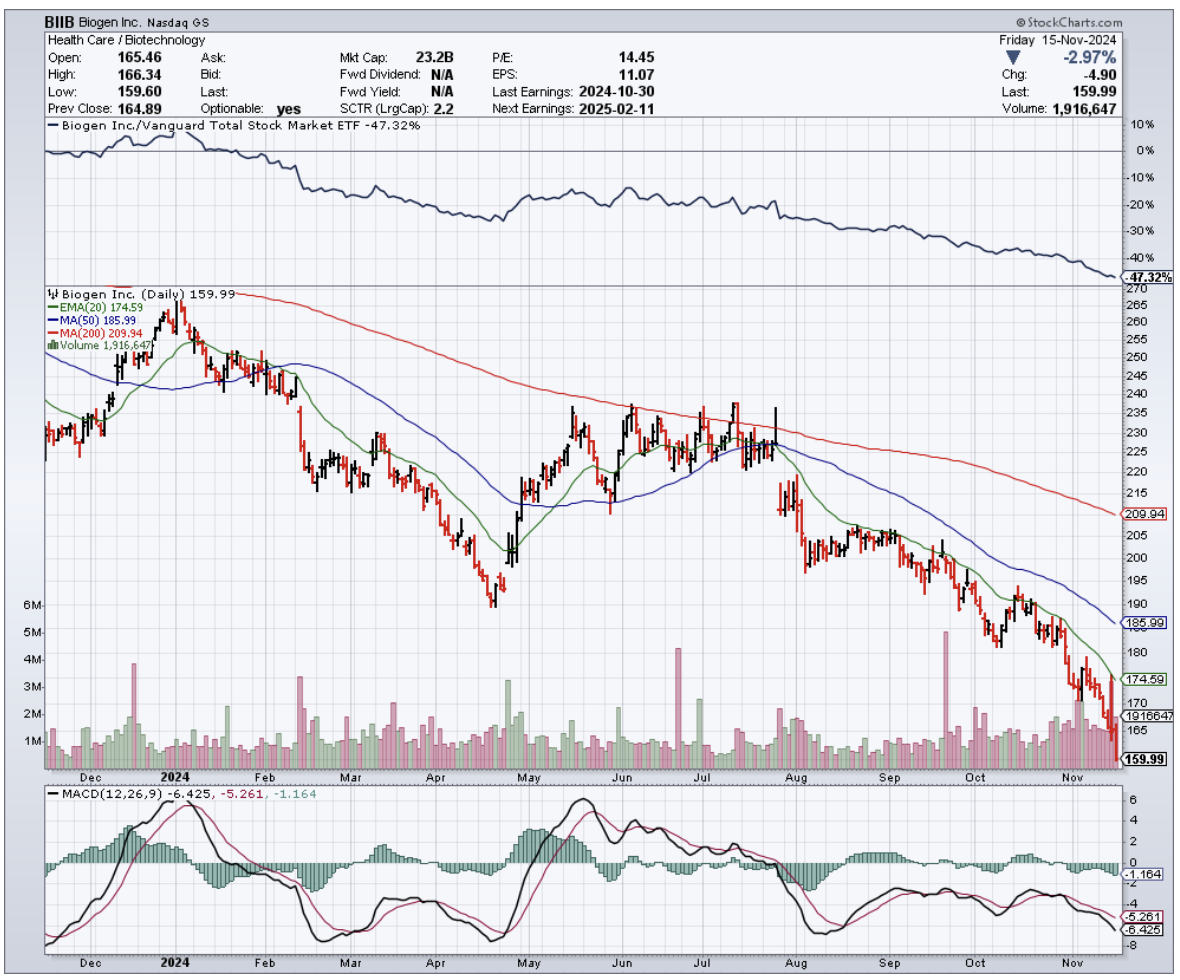
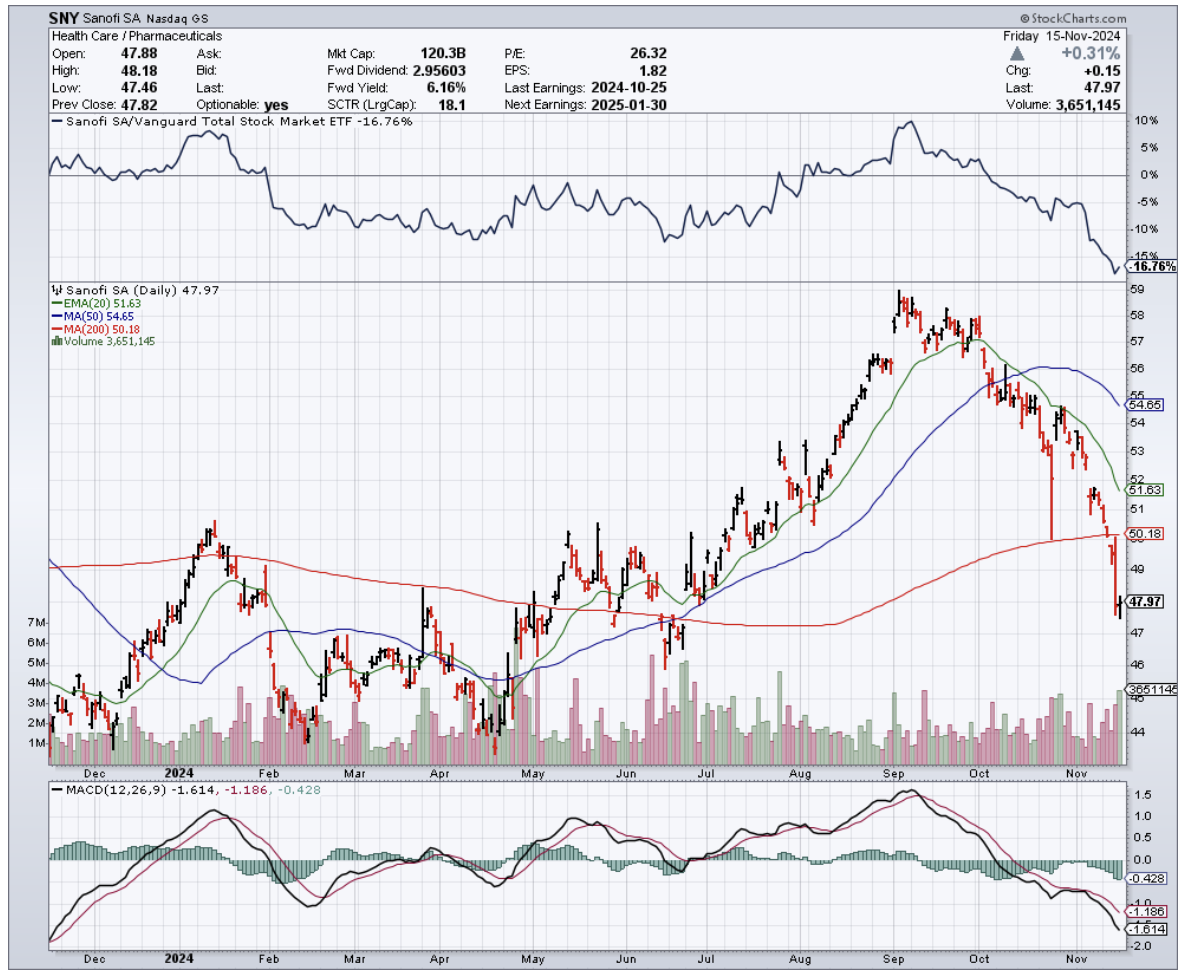
Legal Disclaimer
There is a very high degree of risk involved in trading. Past results are not indicative of future returns. MadHedgeFundTrader.com and all individuals affiliated with this site assume no responsibilities for your trading and investment results. The indicators, strategies, columns, articles and all other features are for educational purposes only and should not be construed as investment advice. Information for futures trading observations are obtained from sources believed to be reliable, but we do not warrant its completeness or accuracy, or warrant any results from the use of the information. Your use of the trading observations is entirely at your own risk and it is your sole responsibility to evaluate the accuracy, completeness and usefulness of the information. You must assess the risk of any trade with your broker and make your own independent decisions regarding any securities mentioned herein. Affiliates of MadHedgeFundTrader.com may have a position or effect transactions in the securities described herein (or options thereon) and/or otherwise employ trading strategies that may be consistent or inconsistent with the provided strategies.
This site uses cookies. By continuing to browse the site, you are agreeing to our use of cookies.
OKLearn moreWe may request cookies to be set on your device. We use cookies to let us know when you visit our websites, how you interact with us, to enrich your user experience, and to customize your relationship with our website.
Click on the different category headings to find out more. You can also change some of your preferences. Note that blocking some types of cookies may impact your experience on our websites and the services we are able to offer.
These cookies are strictly necessary to provide you with services available through our website and to use some of its features.
Because these cookies are strictly necessary to deliver the website, refuseing them will have impact how our site functions. You always can block or delete cookies by changing your browser settings and force blocking all cookies on this website. But this will always prompt you to accept/refuse cookies when revisiting our site.
We fully respect if you want to refuse cookies but to avoid asking you again and again kindly allow us to store a cookie for that. You are free to opt out any time or opt in for other cookies to get a better experience. If you refuse cookies we will remove all set cookies in our domain.
We provide you with a list of stored cookies on your computer in our domain so you can check what we stored. Due to security reasons we are not able to show or modify cookies from other domains. You can check these in your browser security settings.
These cookies collect information that is used either in aggregate form to help us understand how our website is being used or how effective our marketing campaigns are, or to help us customize our website and application for you in order to enhance your experience.
If you do not want that we track your visist to our site you can disable tracking in your browser here:
We also use different external services like Google Webfonts, Google Maps, and external Video providers. Since these providers may collect personal data like your IP address we allow you to block them here. Please be aware that this might heavily reduce the functionality and appearance of our site. Changes will take effect once you reload the page.
Google Webfont Settings:
Google Map Settings:
Vimeo and Youtube video embeds:
